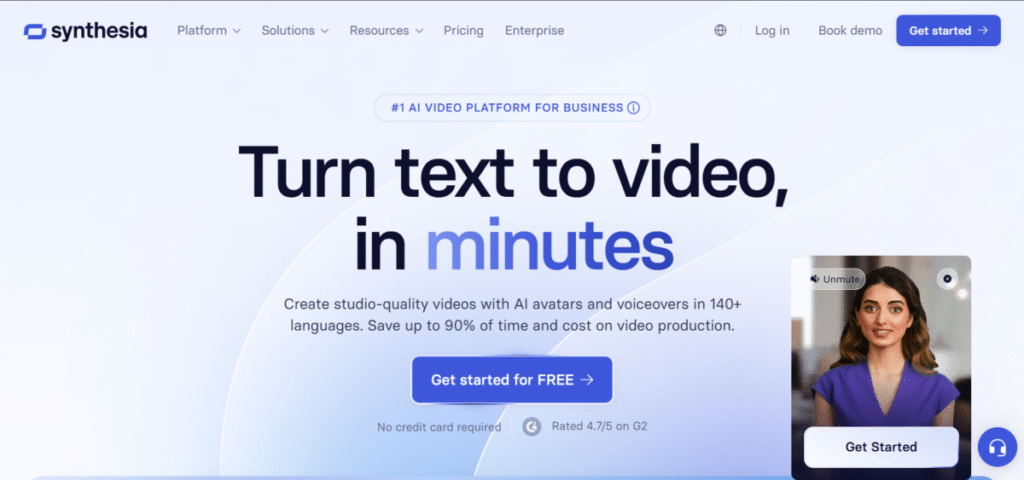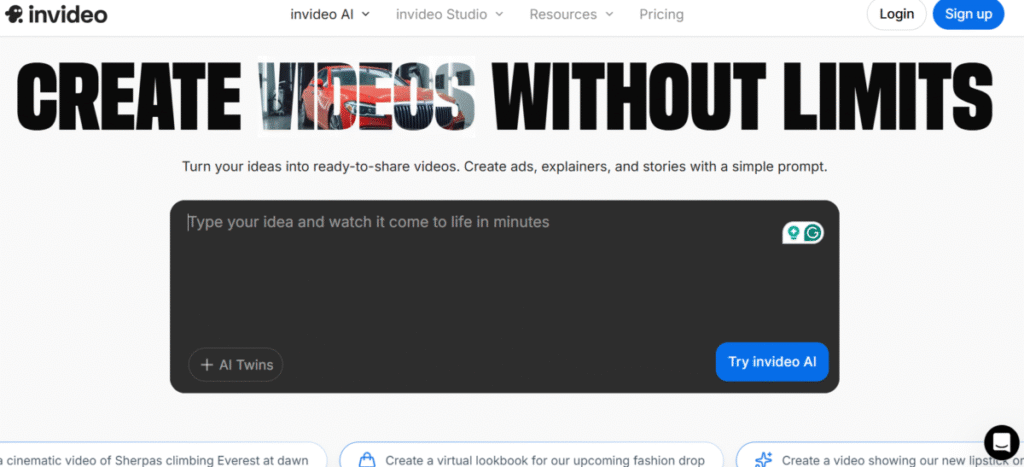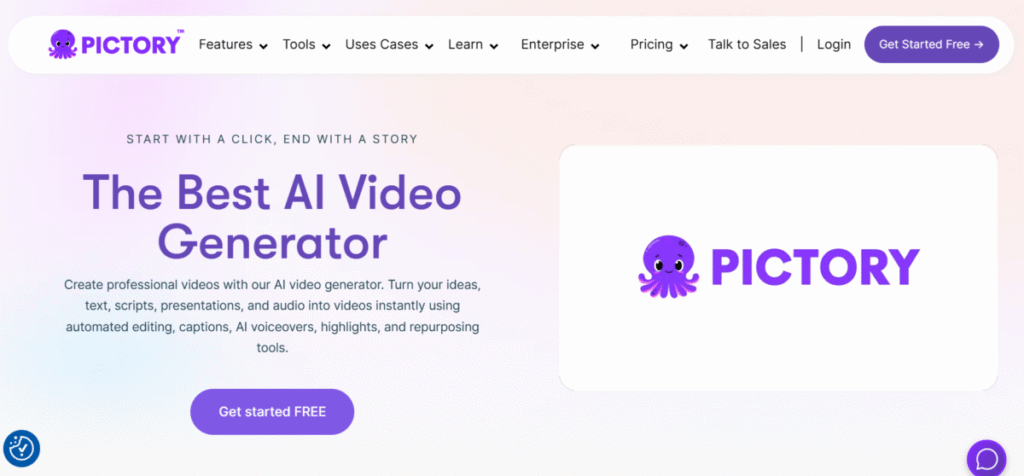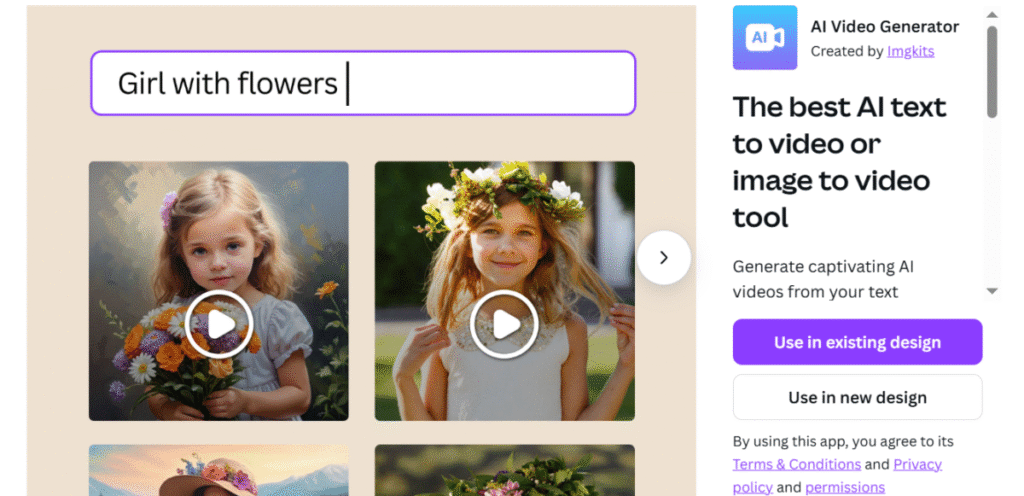No longer does anyone have to spend long hours behind the screen manually creating videos. Endless hours of filming, trimming shots, and cropping have given way to the ease and creativity of text-to-video AI tools.
Business owners use them for marketing, educators use them to improve students’ learning abilities, and content creators turn to them for creative stories. These tools save time, cost and energy.
In this post, we will provide a list of the top 10 text-to-video AI tools, highlighting their most prominent features, pros, and cons.
1. OpenAI Sora

OpenAI Sora is a text-to-video tool that creates cinematic and lifelike videos. The video quality is born from its understanding of physics, camera movement, lighting, and real-world movement. This goes against the rough edits lower-tiered tools typically create.
Open Sora AI gets the aura of the scene and can create complex scenes containing diverse characters embedded with a specific motion. It pays attention to minute details such as lighting, shadows and texture. Its ability to create one-minute-long videos is great for content creators and filmmakers.
Features
- OpenAI Sora reads and interprets users’ prompts. It includes the emotions, tone and pacing to make the video realistic.
- OpenAI Sora can generate high-resolution, one-minute-long videos from text prompts.
- Sora supports multi-character scenes. The characters interact with one another and their surroundings.
- The visuals are Hollywood-standard. It gets the smooth camera movement, dynamic lighting and realistic textures.
- It has an advanced physics stimulator to stimulate gravity, fluid dynamics, and collision.
- Users can edit text prompts or tweak individual frames of a video. This feature allows for fine-tuning of visuals.
- Sora is capable of batch processing videos to create multiple variants.
Pros
- OpenAI Sora can handle complex scenes and multiple characters
- It creates realistic and real-life videos.
- The videos are high resolution and Hollywood standard.
Cons
- Compared to competitors, it lacks an in-built library.
- It may be expensive for small teams or individual users.
2. Google Veo

Google Veo is Google’s AI tool to transcribe texts to videos. As a super smart video maker, it brings videos to life. It is known as Sora AI’s biggest competitor. Sora impresses users visually, while Google Veo impresses technically.
Due to its integration with Google’s ecosystem, Veo syncs effortlessly. Google Veo interprets prompts accurately and produces high-quality edits. Moreover, it relies on Google’s cloud, making it possible to handle prompts at high resolution. Veo is ideal for professionals, marketers and filmmakers.
Features
- Google Veo generates 1-minute-long videos from texts and images.
- It allows real-time editing. Users can pause to adjust colour, speed or tone to suit their taste.
- The tool produces high-resolution (1080p) visuals.
- It integrates with Google Tools for easy sharing. Also, with YouTube and Google Cloud Storage for easy deployment.
- Google Veo uses AI to suggest improvements in lighting and tone.
- Users can process multiple videos within seconds.
Pros
- Google Veo integrates smoothly with Google tools.
- It is a great choice for short videos, ads and documentaries
- Its video quality is top-notch, rivalling Open Sora AI.
Cons
- Google Veo is not a beginner-friendly tool.
- It has a free tier, but with restrictions on video length.
- The tool relies on Google Cloud, which can impact speed.
3. Runway

Runway has established itself as a companion tool and creative powerhouse. Runway is for designers, editors and filmmakers. This audience specificity is tied to a range of tools, including text-to-video editing, motion tracking, object removal, and green screen capabilities.
Also, Runway is user-focused, and it integrates well with creative software like Adobe Premiere. This makes it distinct from other tools such as Open Sora AI and Google Veo.
Features
- Runway converts text to video with adjustable parameters.
- It allows real-time collaboration among teammates.
- The tool has an array of creative controls. Users can add new prompts on top of existing videos for a better result.
- Runway delivers videos in high quality within seconds.
- Its AI editing tool, which comprises background removal, text editing and green screen features, is top-notch.
Pros
- Runway has a beginner-friendly interface.
- It is tested and trusted by filmmakers, directors and other professionals.
- The tool is the best for all AI video editing needs.
Cons
- The duration of the videos is too short.
- The premium plan is expensive
4. Pika Labs

Pika Labs is a free platform that has built a name worldwide. It is best known for its flexibility, simplicity, speed and innovation. Pika Labs may not create lifelike videos like Sora and Veo., but it is a creative playground for trying out and experimenting with new ideas.
Some of its special features include lip sync, sound effects and the ability to extend the video canvas. It is ideal for business owners, content creators, and educators.
Pika Labs makes text-to-video simple.
Features
- Pika Labs is the go-to for quick, short videos. It can generate a video from a text within 10 seconds.
- The tool supports text/image to video generation.
- The “Modify Region” feature allows users to alter parts of a video to insert a new prompt.
- It has a lip-sync feature that matches audio to video.
- The tool is available on mobile apps to ensure easy accessibility.
Pros
- It is a fun tool for creative ideas.
- Pika Labs has a free plan suitable for beginners.
- The tool’s lip-sync feature is top-notch.
Cons
- The video’s short length limits storytelling.
- It is not suitable for professional cinematic videos.
- Compared to other tools, it produces low-quality videos.
5. Luma AI Dream Machine

Luma AI is relatively new but popular for its 3D capture technology, which turns 3D into video. Its Dream Machine, a text-to-video tool, gained traction for its surreal, realistic, and artistic videos, which border on cinematic storytelling.
Also, Dream produces smooth, natural motions and handles depth and perspectives well. It is commonly used by business owners and creators.
Features
- It creates high-resolution videos from texts (up to 5 seconds).
- Luma AI works well with other 3D creative tools to bring users’ ideas to life.
- The tool can handle complex camera movement easily.
- Luma has an image-to-video feature where users can upload images to create videos.
- Its lighting model makes lighting look natural with shadows and colours that fit the scene.
- The tool allows team collaboration via cloud sharing.
Pros
- Luma AI Dream Machine is great for filmmakers and 3D artists.
- It has a free plan with a limited number of videos monthly.
- It has a user-friendly interface.
- The tool is great for video that requires character animation.
Cons
- There is a lag in producing high-quality videos.
- Dream Machine functions less as an editing platform.
6. HeyGen

HeyGen’s unique feature is its talking avatar videos that involve using AI presenters to convert texts into videos. Users script dialogue, and the avatar delivers naturally. Among all the avatars available, HeyGen is the most realistic. And its lip-syncing technology is top-notch. This makes it a go-to tool for businesses seeking personalization.
Features
- HeyGen generates videos with customizable avatars.
- The tool has over 300 avatars and voices.
- It supports multilingual translation of over 40 languages.
- HeyGen has a library of customizable templates available to users.
- The tool allows real-time collaboration among team members.
- HeyGen has exceptional lip and audio sync.
Pros
- HeyGen has the most realistic avatars available.
- It is easy to use and beginner-friendly.
- The tool is great for making short clips
Cons
- It relies heavily on an internet connection.
- The pricing can be too expensive for individual creators.
- Oftentimes, the avatars may appear too robotic.
7. Synthesia

Synthesia is an established text-to-video tool for producing studio-quality videos. Its enterprise integration and security customization, coupled with its excellence as a presentation creation tool, make it trusted by larger companies.
Features
- Synthesia has over 160 realistic avatars and voices.
- The tool supports over 120 languages to include diversity.
- Companies can create their professional avatars.
- Synthesia can turn written text into words with natural cadence.
- Users can insert their logos, brands and fonts that define them.
- The AI tool provides users with a detailed analysis of video engagement.
Pros
- Synthesia creates professional avatars.
- The tool is ideal for large companies.
- Avatars can be customized to suit a brand’s needs.
- It produces high-quality studio-like results.
Cons
- The premium is expensive.
- Avatars may appear stiff and lack emotional depth
8. InVideo AI

InVideo AI is a one-in-all content creation tool that bridges the gap between video editing and AI content generation. It is simple to use, has a fast turnaround rate, and is a great choice for creating ads, social media posts, and short clips. It is a marketer and content creator’s dream.
Features
- InVideo AI has an array of pre-designed text-to-video layouts
- Users have access to a library of stock videos, images and music tracks.
- The tool has an AI script assistant which previews texts before converting them into videos.
- InVideo is suitable for multiple social media platforms.
- It supports multilingual translation in over 10 languages.
Pros
- InVideo AI has a fast turnaround time.
- It has a user-friendly interface for non-experts.
- The tool is affordable for small teams and individuals.
Cons
- The free version contains a watermark.
- It is time-consuming to export longer videos.
- InVideo AI is not as innovative as other specialized tools.
9. Pictory

Pictory is similar to InVideo AI; however, it turns long-form content and articles into videos. It has fast content summarisation and editing tools that scan articles in seconds, highlight the key points and create a visual story. This is a great tool for SEO specialists, bloggers, educators and marketers.
Features
- Pictory converts long articles into videos.
- Users can upload their voices for voice-overs or use AI voices.
- The tool uses Natural Language Processing (NLP) for accuracy.
- It provides brand customization tools to maintain consistency in a video.
- Pictory has a library that contains over 3 million stock videos and tracks.
Pros
- Pictory is a great tool for bloggers, SEO specialists and marketers.
- It has a simple and user-friendly interface.
- Pictory is a specialized tool.
- The premium plan is affordable.
Cons
- It is not suitable for cinematic videos.
- There are limited customizable options.
- Unlike InVideo, Pictory is less versatile in creating videos from scratch.
Also read: Pictory AI Review (2025): Pricing and Features.
10. Canva AI

Typically, Canva AI is used for design. It, however, has capabilities that extend to text-to-video creation. Canva is simple to use; users can navigate from posters to presentations seamlessly in one space. Although the videos may not be as cinematic as Open Sora AI, they serve content creators and social media marketers.
Features
- Canva AI can turn text into videos with one click.
- Canva Magic Write can brainstorm and generate video clips.
- The Canva Editor can add text, animations, and music to a video clip for more appeal.
- Canva has other features, such as Magic Eraser and Magic Studio, for background removal and auto editing.
- Canva AI allows real-time collaboration among team members.
Pros
- Canva AI is available on mobile apps and desktop.
- The tool has seamless integration with Canva Suite.
- It has a user-friendly interface
- Canva AI is the quickest way to add a video on social media.
- It has a free plan that allows access to basic features.
Cons
- The premium features can be accessed via subscription.
- The tool is too basic for professionals.
The Bottom Line
Needs, depth of realism, affordability, and flexibility are important factors to consider when choosing a video generation tool. Users on a tight budget should opt for Pika. Business owners will tilt more towards HeyGen and Synthesia for professional avatar videos.
Sora and Veo are undisputed champions of high-quality videos; however, their accessibility is limited. Finally, for marketers and content creators, InVideo AI, Pictory, and Canva AI are preferable.
FAQs
1. What Is the Best AI for Text to Video?
We recommend OpenAI Sora and Google Veo for cinematic and realistic videos. For fast social media content, we recommend InVideo AI and Pictory.
2. Can ChatGPT Make AI Videos?
No, ChatGPT cannot make AI videos. But it can help users create scripts and prompts to be used in Sora, Runway, and Synthesia.
3. How Do I Convert Text to AI Video?
- Choose a tool (Synthesia, OpenAI Sora).
- Write a detailed and descriptive prompt.
- Click on “Generate”.
- Edit and refine the video to your taste.
- Export the final results.

